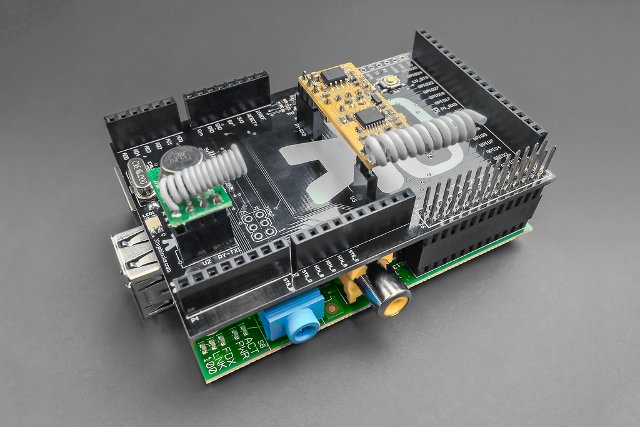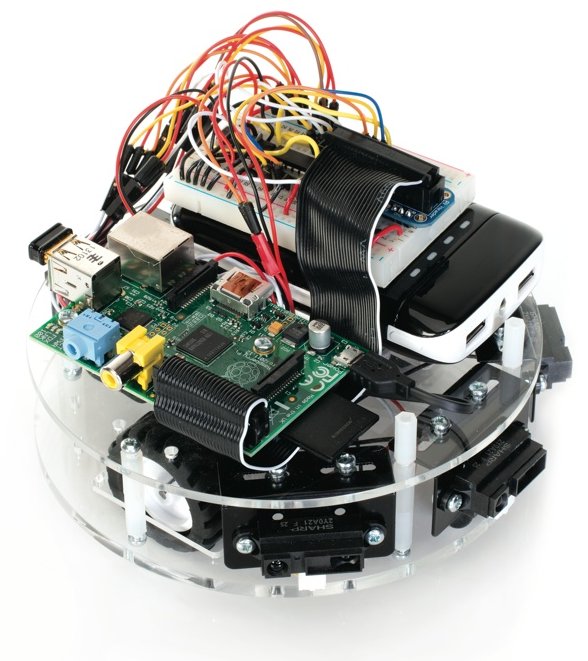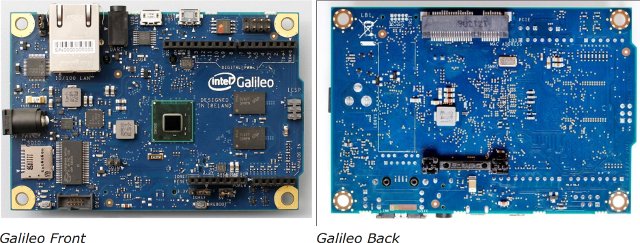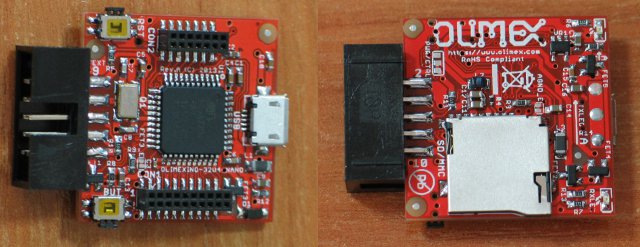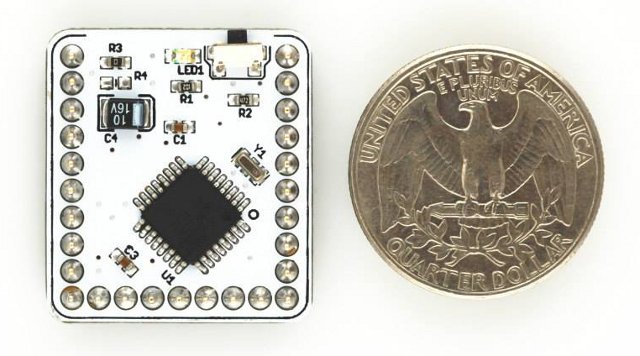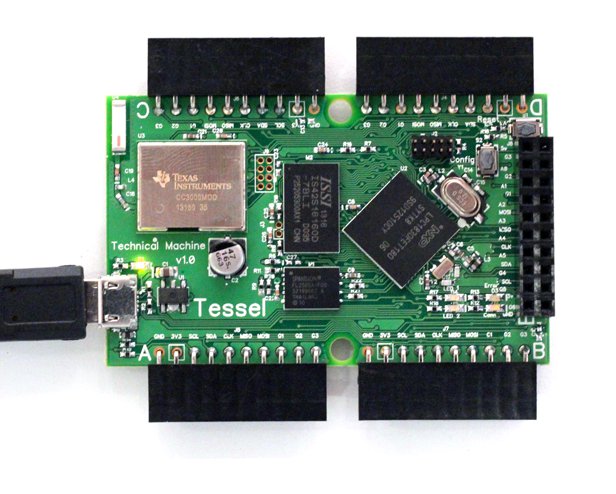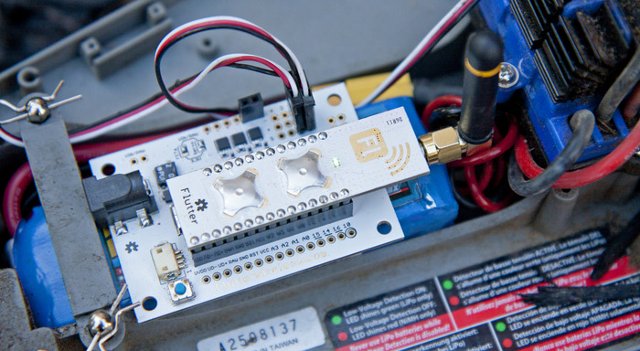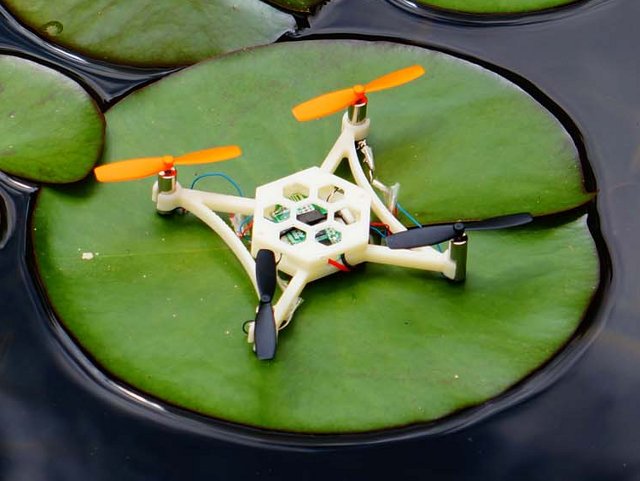There are quite a few projects using both the Raspberry Pi and an Arduino board and its shields together. These are working but the cabling may get messy. People have already found solutions to plug Arduino shields into the Raspberry Pi with products such as Cooking Hacks’ Raspberry Pi to Arduino shield connection bridge (40 Euros) or Open Electronics’ Raspberry Pi bridge (22.50 Euros). Those two boards are fine, but do not include an Atmel MCU, and use Raspberry Pi GPIOs directly, except for their ADC. Another solution is the Paperduino Pi, a DIY Arduino board that can be plugged on top of the Raspberry Pi, and compatible with Arduino shields. But if you want an Arduino board that can easily be stacked between the Raspberry Pi, and Raspberry shield, the upcoming Ninja Pi Crust by Ninjablocks may be an interesting option, especially if you plan to use the 433MHz […]
Frindo Open Source Robotics Platform for Arduino and Raspberry Pi Boards
Frindo is both a community and an open source robotics platform designed to work with Arduino, Raspberry Pi, and possibly other micro-controller boards. The platform is said to have been designed as an educational platform so that beginners can start with a simple robot, and build a more complex robot as their skills grow. There are currently three Frindo kits available from RobotBits.co.uk: Frindo chassis only kit for £64.95 (~$104) – Chassis plates, motors, wheels, wheel brackets, Arduino & Pi mounting kit & all hardware. Frindo Arduino kit for £110.95 (~$178) – Chassis only kit + Arduino, RobotShield, battery clip, power cable & USB cable Frindo Arduino kit plus sensors for £159.9 (~$257) – Arduino kit + 3x each: GP2Y0A21 analog distance sensors, bracket, cable & fixings The RobotShield is an Arduino shield optimized for mobile robotics applications with the following features: Dual bi-directional motor driver circuit (2 Amp Peak, […]
$69 Intel Gallileo Development Board Combines x86 Processor and Arduino Compatibility
After UDOO, a Linux development board powered by Freescale i.MX6 ARM Cortex 9 processor and an Atmel SAM3U MCU for Arduino compatibility, here’s another single board computer (SBC) that both runs Linux, and is claimed to be software and hardware compatible with shields designed for Arduino Uno R3: Intel Gallileo. Instead of using two ARM processors, the board is powered by Intel Quark SoC X1000, a 32-bit Pentium class SoC, that handles both Linux and I/Os. Intel Galileo Specifications: SoC – Intel Quark SoC X1000 @ 400MHz with 16 KBytes on-die L1 cache, 512 KBytes of on-die embedded SRAM, single thread, single core, constant speed, ACPI compatible CPU sleep states supported, and integrated Real Time Clock (RTC). Max TDP: 2.2W. System Memory – 256 MByte DRAM Storage – 8 MByte Legacy SPI Flash for bootloader and sketch + 11 KByte EEPROM + optional microSD card (Up to 32GB) Connectors: 10/100 […]
Olimex Announces OLIMEXINO-NANO, a Tiny Arduino Leonardo Compatible Board
Last month, I wrote about Microduino, a tiny Arduino compatible board about the size of a coin. Olimex has also being working on their own tiny version of the Arduino board, OLIMEXINO-NANO, slightly larger than Microduino (30x30mm vs 25.4×27.94mm) but also featuring the UEXT connector which is an advantage if your own or plan to use UEXT expansion boards, but it could be an inconvenience if you don’t, as the connector is a little bulky. Here are the specs of the board: MCU – Atmel ATMega32U4 processor (Leonardo compatible) with 2.5KB RAM, 32KB flash memory, and 1KB EEPROM. Storage (external) – microSD card connector for data logging on SD-card USB – micro USB connector for programming and power supply when debugging Misc – RESET button, USER button, 2x status LEDs Expansion Connectors: UEXT connector for RF, Zigbee, Ethernet, RELAY, RGB LED, etc UEXT modules Connector 14 pin 0.05″ Connector 20 […]
Microduino Is a Tiny Arduino Compatible Board with Stackable Shields
Microduino is a small board based on Atmel AVR or ATMega MCU which is software compatible with Arduino boards. The core board features the Atmel MCU, and Microduino shields can be stacked on the core board to add functionalities. There are actually 2 core boards: Microduino core and Microduino core+ with more performance. They share the following specifications: MCU: Core – Atmel ATmega328P or ATmega168PA, equivalent to Arduino UNO Core+ – Atmel ATmega644PA or ATmega1284P, with performance matching that of the Arduino Mega2560. System Memory – 1K to 16K SRAM on-chip Storage – 16K to 128K flash + 512 bytes to 4KB EEPROM on-chip Operating Voltage: 5V/3.3V Input Voltage (limits): 6-20V Digital I/O Pins: 14, including 6 capable of PMW output, plus serial, SPI, TWI, Analog Input Pins: 8 (2 more compared to Arduino Uno) DC Current per I/O Pin: 40 mA DC Current: 50 mA Dimensions – 25.40mm X […]
Tessel ARM Cortex-M3 MCU Board Brings Hardware Hacking to Web Developers with JavaScript and Node.js
People who are proficient with JavaScript or web technologies may not be completely comfortable with programming MCU in assembler and/or C programming language. Node.js, written in JavaScript, seems to be quite popular this days for diverse projects, but technical.io has decided to design a board called Tessel, powered by a Cortex M3 MCU. that can be fully programmed with JavaScript/Node.js. Tessel hardware specifications: MCU – NXP LPC1830 ARM Cortex-M3 @ 180mhz System Memory – 32MB SDRAM Storage – 32MB Flash Connectivity – Wi-Fi via TI CC3000 Expansion – 16-pin GPIO bank for prototyping Power – Micro USB or battery The board is said to be compatible with 1000’s of Node.js modules from NPM, can be programmed via USB or Wi-Fi using your own IDE, and support Tessel modules, as well as Arduino Shields. There are two (price) classes for Tessel modules: Class A: Relay — turn devices on and off (up […]
$25 Flutter is a Wireless Arduino compatible Board with Up to 1 km Range
There are already several ways to add wireless connectivity to your hardware project. For short ranges, we can use protocols such as Bluetooth (e.g. RFDuino, BLEDuino projects, or Bluetooth USB dongle), for much longer ranges 3G/4G connectivity may be required, and achievable via a 3G/4G USB dongle, or SparqEE CELLv1.0 project for example. But what if you want something in the middle with a range closer to 1km? Flutter boards using the 915MHz band (US only) can provide such range, and are software compatible with the Arduino. There are two version of the board: Flutter Basic – Board with an low-profile integrated antenna. It features micro USB for power, an LED, and a button, as well as several digital and analog I/O. Flutter Pro – Board with external antenna (and probably longer range). It comes with all features found in Flutter Basic, and adds battery charging, an additional button, and […]
$49 (and up) Hex is an Arduino-compatible, Soon-to-be Open Source Nanocopter Kit
Do you remember Mecam, an upcoming $49 nanocopter with a camera? AFAIK, it’s not there yet, but a similar product with a similar price point is now “available” on Kickstarter. Hex nanocopters (quadcopter and hexacopter versions) are not voice-controlled, and do not come with a camera by default, but you can control them with iOS or Android mobile devices, and a camera can be fitted if needed. It comes as a kit, so you’ll have to assemble it yourself, and since it’s fully open source, you could even customize it to your taste. Hex specifications: Propellers – Size: 56×8.5 mm, Fits shaft: 1.0 mm Motors – Diameter: 7.0 mm, Length: 20 mm, Shaft diameter: 1.0 mm, Over 50,000 rotations per minute (rpm) Flight Control System: Flight control – Microwii Copter Processor – Atmel ATMega32u4 Gyro and Accel – InvenSense MPU6050 (6-axis) Battery – 350mAh battery (Flight Time – 7 minutes) […]


